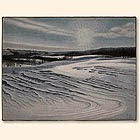 |
| Tracey in her studio |
How did you get started?
I started with embroidery when I was very young. I’ve always liked sewing and handwork. About 20 years ago I took a hand quilting class at a local shop and haven’t looked back. There’s so much variety in quilting. I joined York Heritage Quilters Guild and I kept taking classes and trying different techniques and styles.
What was your first National Juried Show Entry?
I joined CQA when I entered the National Juried Show in 2008. I was very pleasantly surprised when my quilt “Linear Progression” was accepted. I went to St. John’s Newfoundland for the show and really enjoyed it. I’m now a CQA Certified Quilt Judge and I had the honour of judging the 2012 NJS in Halifax with Margie Davidson and Leone Strukoff. I’ve been to several conferences and always enjoy reconnecting with friends and seeing all the beautiful quilts.
 |
| Linear Progression |
 |
| Ready |
In your presentation you talk about creativity and experimentation…how does this factor into your work?
I believe that everyone is creative but we express our creativity in different ways. Experimenting, trying things, failing and succeeding are ways in which we learn and they are important steps to finding our individual artistic voice. I developed my technique for my densely stitched landscapes and my three-dimensional still-life as the result of experimenting with my longarm to see what I could do. And of course, I continue to try new things.
Tell us about your piece in “It’s Time for Colour”
“Water Play” is all about experimentation and play. I was interested in learning about wet felting and I signed up for a class with Carol Seeley at Quilt Canada 2014 in St. Catharines. I had no plan or design in mind, I just wanted to learn how it was done. I picked out some green, blue, and purple (an analogous colour scheme that I like) as well as some white and black wool roving, then layered and arranged the coloured wool in a pleasing pattern…something that indicated movement. I wet and soaped it; mixed in a few other miscellaneous yarns; and then rolled and rolled and rolled; and finally washed and rinsed it to make a piece of felt. It was a fairly uneven first attempt, but a good learning experience. When CQA requested a piece for the “It’s Time for Colour” show, this seemed the perfect starting point.
 |
| Water Play from It's Time for Colour |
Back in my studio, I thought the result looked like water with plants floating in it, so I went with that. I set the felt on some cotton fabric and started free-motion stitching with various threads on my APQS Freedom longarm. I stitched a bit with my Janome 6600 too. I incorporated a few additional yarns and metallic threads. At one point I thought I might add some contrasting complementary colours (maybe peach, apricot or yellow-orange). However, when I auditioned those bits I thought they were too strong and detracted from the flow of the piece. I decided that the vibrant blue would have to carry the day in terms of colour. In this way the piece developed organically. I just tried things as I went along to see what would happen. I guess this is what happens when you play with water!
 |
| Windsweot Snow |
What is your favourite quilt?
It’s usually my most recent piece. “Windswept Snow” is a particular favourite and I was thrilled that the Canadian Quilter chose it for the cover of the Winter 2014 issue. I’m currently working on a new body of work with larger pieces that will be exhibited at David Kaye Gallery in Toronto in March 2016. I’m very excited about this new work.
How long does it take to do a piece?
The short answer is months though it’s not as straightforward as that. Every piece is different. There are many steps to creating my landscapes and still-life and the first steps are impossible to measure. I never know where the initial inspiration will come from, maybe a plant in my garden, the light on a particular day, something I see as I’m driving through the countryside or an event of some sort.
Once I realize “I want to do that”, there is an incubation period that is sometimes short and sometimes long. At that stage I’m consciously and subconsciously thinking through the approach, the design, the technique and how I might achieve my desired final result. After that I put pencil to paper and lay out the composition, collect materials, and get underway…for months!
Tracey likes to focus her energy on her studio work but does speak to groups where she encourages quilters to develop their creativity.
Looking forward to seeing what Tracey has entered in this year's National Juried Show in Lethbridge, AB.......
I loved "Windswept Snow" when I saw it at the CQA show. Wonderful piece.
ReplyDelete